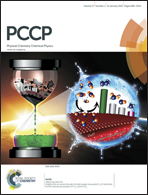Calculation of the chemical potential and the activity coefficient of two layers of CO2 adsorbed on a graphite surface†
Abstract
We study the adsorption of carbon dioxide at a graphite surface using the new Small System Method, and find that for the temperature range between 300 K and 550 K most relevant for CO2 separation; adsorption takes place in two distinct thermodynamic layers defined according to Gibbs. We calculate the chemical potential and the activity coefficient of both layers directly from the simulations. Based on thermodynamic relations, the entropy and enthalpy of the CO2 adsorbed layers are also obtained. Their values indicate that there is a trade-off between entropy and enthalpy when a molecule chooses for one of the two layers. The first layer is a densely packed monolayer of relatively constant excess density with relatively large repulsive interactions and negative enthalpy. The second layer has an excess density varying with the temperature, an activity coefficient, which also indicates repulsion, but to a much smaller degree than in the first layer. Results for activity coefficients, entropies and enthalpies can be used to model transport through and along graphitic membranes for carbon dioxide separation purposes.


 Please wait while we load your content...
Please wait while we load your content...